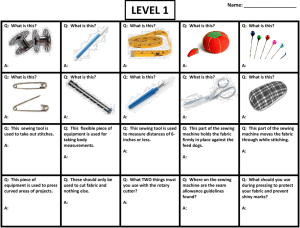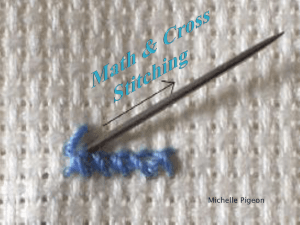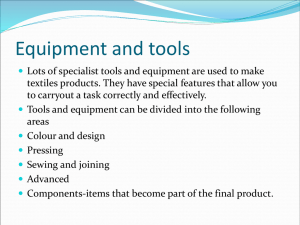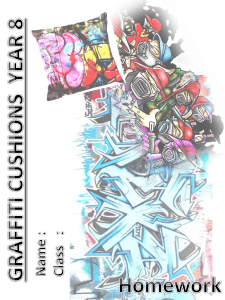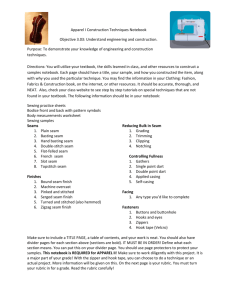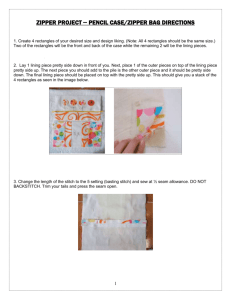LEVEL 6 Name: Directions
advertisement
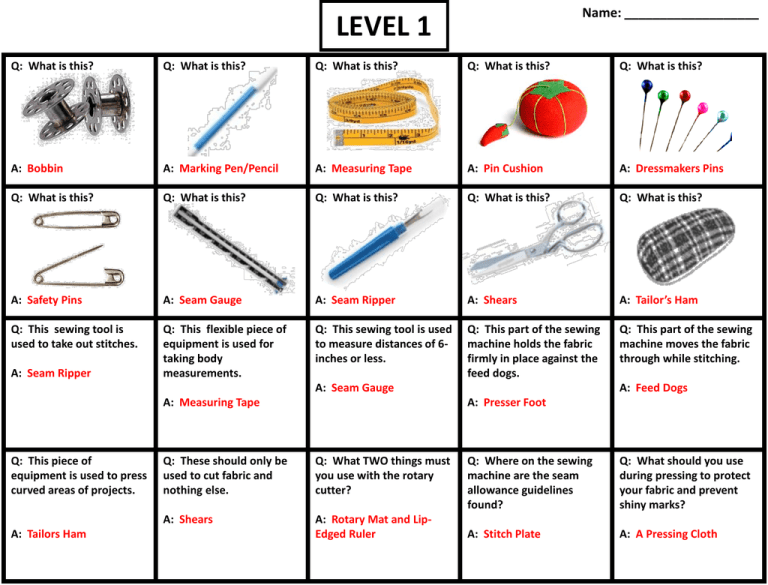
Name: ___________________ LEVEL 1 Q: What is this? Q: What is this? Q: What is this? Q: What is this? Q: What is this? A: Bobbin A: Marking Pen/Pencil A: Measuring Tape A: Pin Cushion A: Dressmakers Pins Q: What is this? Q: What is this? Q: What is this? Q: What is this? Q: What is this? A: Safety Pins A: Seam Gauge A: Seam Ripper A: Shears A: Tailor’s Ham Q: This sewing tool is used to take out stitches. Q: This flexible piece of equipment is used for taking body measurements. Q: This sewing tool is used to measure distances of 6inches or less. Q: This part of the sewing machine holds the fabric firmly in place against the feed dogs. Q: This part of the sewing machine moves the fabric through while stitching. A: Seam Ripper A: Seam Gauge A: Measuring Tape Q: This piece of equipment is used to press curved areas of projects. A: Tailors Ham A: Feed Dogs A: Presser Foot Q: These should only be used to cut fabric and nothing else. Q: What TWO things must you use with the rotary cutter? A: Shears A: Rotary Mat and LipEdged Ruler Q: Where on the sewing machine are the seam allowance guidelines found? Q: What should you use during pressing to protect your fabric and prevent shiny marks? A: Stitch Plate A: A Pressing Cloth Name: ___________________ LEVEL 2 Q: What is this symbol? Q: What is this symbol? Q: What is this symbol? Q: What is this symbol? Q: What is this symbol? A: Place on Fold A: Grainline A: Notch A: Button A: Buttonhole Q: What grainline is shown below? Q: What grainline is shown below? Q: What grainline is shown below? Q: The grainline with the LEAST amount of stretch in a woven fabric is: Q: The grainline with the MOST amount of stretch in a woven fabric is: A: Lengthwise Grain A: Bias Q: What are notches used for? Q: The tightly woven edge on a woven piece of fabric is called the: A: Lengthwise Grain A: Crosswise Grain A: Bias Q: The lenghwise grainline should always run _______ to the selvage. Q: The SOLID line on pattern pieces represents the _________ line. Q: The DASHED line on pattern pieces represents the _________ line. A: Parallel A: Cutting Line A: Stitching Line Q: The handwheel on the sewing machine should always be turned: Q: What are circle/dot, square and triangle pattern markings used for? Q: Why is it important to backstitch? A: Toward You A: The placement of pockets, sleeves and decorations. A: Matching Up Pattern Pieces Q: What does the thread tension on the sewing machine control? A: To reinforce seams A: The Tightness or Looseness of the Thread A: Selvage Q: Before you can begin sewing, the thread take-up lever must be at its _________ point. A: Highest Name: ___________________ LEVEL 3 Q: This is the term for the distance from the raw edge of the fabric to the stitching line. Q: These are long, temporary stitches used to hold fabric pieces together. A: Seam Allowance A: Basting Stitches Q: A casing should be ____ inch(es) wider than the elastic threaded through it. Q: Trimming the layers of the seam allowance to different widths is called: Q: This is the part of the sewing machine that holds the bobbin. Q: Elastic, cording or drawstring is usually threaded through a: A: Bobbin Case A: Casing A: Seam Finishes Q: What is the FASTEST way to finish a seam? Q: The bottom edge finishing of a clothing item is called a: A: Serging A: Grading Q: STRAIGHT cuts in the seam allowance, (but not through the stitching), is called: A: Hem A: 1/4” Q: TRIANGULAR cuts in the seam allowance, (but not through the stitching), is called: Q: This is the term for the methods of finishing seam allowances so that they won’t fray or unravel. A: Clipping Q: This is an easy way to quickly turn corners while stitching without taking the fabric out of the machine: Q: The number one rule of pressing is: Q: Stitch length must be lengthened in order to: A: Press As You Go A: Baste Stitch Q: The bottom corners of a square or rectangular patch pocket should be _________ to create sharp right angles. A: Notching A: Pivoting Q: This is added to commercial patterns to allow for wearing comfort. A: Ease Q: Interfacing is used mainly to add: A: Stability to Other Fabrics A: Mitered Q: This is the TYPE OF FABRIC made by two or more yarns interlocking each other at right angles. Q: This is the TYPE OF FABRIC made by the continuous interlocking of yarns into loops. Q: This is the TYPE OF FABRIC made by fibers matted together and set with heat and moisture. A: Woven Fabric A: Knit Fabrics A: Non-Woven Fabrics Name: ___________________ LEVEL 4 Q: The metal prong around which stitches are formed on the serger is called the: Q: The part of the serger that trims the fabric as the stitches are formed is called the: Q: Lint in a serger or sewing machine should be: Q: Before you can begin to sew, the presser foot must be ________. A: Removed regularly A: Down Q: The sewing machine forms a stitch when the upper and lower threads ____________. A: Stitch Finger A: Knife Q: If the fabric SNAGS during sewing, it is most likely caused by: Q: If the machine stitches are uneven or looping on either side of a fabric, you should check the: Q: The FIRST thing you should check if your machine is not sewing properly is: Q: Which type of sewing machine needle can be used on most knit and woven fabrics? A: Thread Tension A: The Threading A: Universal Q: What is the standard seam allowance for most commercial patterns? Q: Natural fibers come from _______ and _______. Q: Synthetic fibers are manufactured from _______. Q: Which fibers, natural or synthetic, are extremely heat sensitive? A: 5/8” A: Plants and Animals A: Chemical Substances A: Synthetic Q: What type of fabric is the easiest to sew on? Q: Why are fibers blended together in fabric? Q: What is the most common fiber blend? Q: Which fiber comes from the flax plant? Q: What is the warmest fiber? A: Cotton A: To enhance the positive characteristics of each fiber. A: Cotton/Polyester A: Linen A: Wool A: A Dull or Damaged Needle Q: Following the outside edge of the presser foot will give you what size of seam allowance? A: Interlock Q: The type of thread used for most sewing is: A: All-Purpose Thread A: 1/4” Name: ___________________ LEVEL 5 Q: What is the most important rule of stain removal? A: Treat the Stain Immediately Q: What body measurement should you use when determining the correct size for a shirt? Q: Where are the diagrams for pattern layouts found in a commercial pattern? Q: If your personal measurements place you between sizes on a pattern, which size should you cut out? Q: What section on the pattern envelope would you look in to find the appropriate fabric to use for a project? A: The Larger Size A: The Suggested Fabrics Section Q: When using one-way, or directional fabrics, the pattern pieces must all be going the _______ direction. Q: Illustrations or sketches of all the different constructions options for a pattern are called: Q: Should you wash and dry your fabric before cutting out any pattern pieces? A: Pattern Views A: Yes Q: When replacing the sewing machine needle, the flat side should be toward the ________ of the machine. Q: What is the LOWEST temperature setting on an iron? A: Pattern Guide Sheet Q: What body measurement should you use when determining the correct size for a skirt or pants? A: Notions A: Bust/Chest Q: Topstitching is done approximately _____ inch(es) from the edge. A: 1/4” Q: Everything needed to complete a project except the fabric and patterns are called: A: Full Hips A: Same Q: The term for stitching through a single thickness to add stability and prevent stretching during constructions is: Q: An advantage of cutting on the bias is: A: Stretch A: Stay Stitching A: Nylon A: Back Q: Fabrics with a ______ contain fibers that are short and create texture. Q: What does Clean Finishing prevent on the seam allowance? Q: Separately serged seams are usually pressed _________. Q: Fabric is usually sewn together with _____ sides touching. Q: The most important thing about serging is to leave ________________. A: Nap A: Raveling or Fraying A: Open A: Right or “Ugly” A: A Thread Tail LEVEL 6 Directions: Check off each construction step off with your teacher. 1. Using the attached 8”x8” square, serge around each side using any color of thread. Try not to cut off any material as you serge. Press flat. 2. Fold one edge in 1 1/4 inches. Press in place. 3. Using the left edge of your presser foot, sew a 1/4 inch seam down the top edge of the fold to secure the folded edge. Remember to backstitch at both ends. (CHECK OFF). 4. Place the sample so that the folded edge you’ve just sewn is facing up and on the right. You should see the serging on the edge you’ve just sewn. Take the upper left corner and fold it in diagonally at a right angle at 1 1/4 inches. Press the fold in place. 5. With the corner pressed and flat in place, fold in the left edge of the square and fold down the top edge of the square to create a mitered corner in the upper left hand corner of your sample. Press the two folds in place. (CHECK OFF). 6. Using a 1/2 inch seam allowance, sew down the pressed top and side edges, pivoting at the mitered corner. Remember to backstitch at each end. (CHECK OFF). 7. Fold the bottom edge of the sample in toward the center at 1/2 inch and press in place. Fold that same edge again 1 inch and press in place. 8. Sew along the top edge of the fold at 1/8 inch to secure the fold in place. (CHECK OFF). 9. Place the sample on the table in front of you. All of the folded edges of the sample should be on the same side. With a marking pen or pencil of any color, draw a 2”x2” square in the center of your sample. Try to place it as much in the center of your sample as possible. 10. Sew a straight stitch on this marking, remembering to backstitch at the beginning and end, and pivoting at the corners. (CHECK OFF). 11. Using the left edge of your presser foot as a guideline , sew another box around the first box 1/4 inch away, but this time using a zig-zag stitch (size five). Remember to backstitch at the beginning and the end and also to pivot at the corners. 12. Trim all threads and do a final press of your sample and staple it to this paper with the mitered corner in the upper left hand side. Turn it in to your teacher to be checked. Name: ___________________ Staple Your Sample HERE

